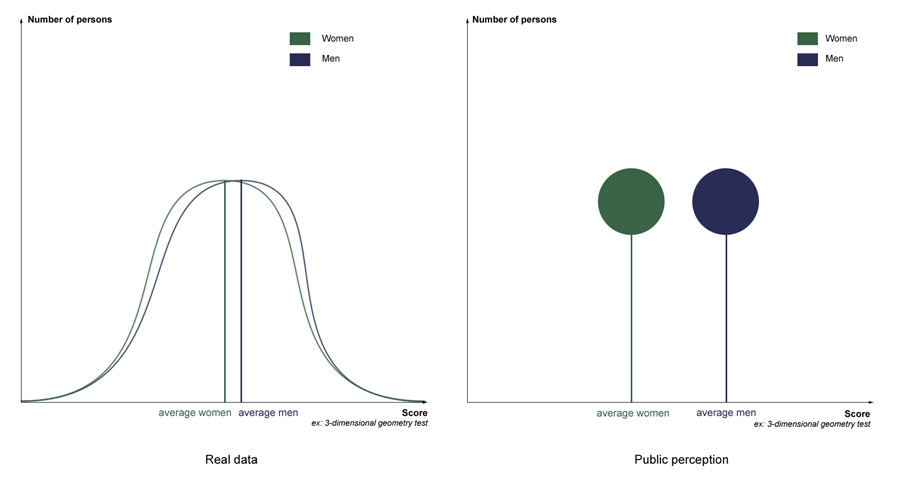We are doomed to make misstake when we try to simplify human attitudes by numbers and categories. The human being and its environment are very complex and to think that we can totally identify and isolate a cause and an effect through an experience is an illusion. How can we put the infinite complexity of nature into a test tube?
Experimentation in humanities
Differential psychology attempt to study the differences between social groups based on experiences and inferential statistics. An experience consists in isolating an independent variable and a dependent variable, to observe the effect of the variation of the first on the second. Inferential statistics uses probability to state whether differences found on samples of subjects are “significant”, that is, if the difference is big enough to make sense, and how much we can generalize on the parent population, with a margin of error.
There are several things to be aware of about these experiences:
– Correlation does not mean causality. If two factors are correlated, for example gender and performance, this does not mean that one explains the second. More relevant factors may be educational, such as toys that subjects received in childhood and that influenced cognitive development.
– These results are not definitive. A person can improve her/his performance in one area through exercise or change attitudes by changing self-image. The brain is a very flexible organ.
For example, according to a study by Kass, A.J. Ahlers R.H. and M. Dugger, (1998), with learning, differences in spatial geometry scores disappear.
– These results are not systematic, there are people who have an excellent performance in a task in which their socio-cultural group uses to perform badly, and the other way round may be true too. Results generally follow a Gaussian curve, which is a reversed bell, the majority of the scores grouping around the average. When the performances of two groups of subjects differ, it is according to two Gaussian curves which intersect. this means that even if there is a “significant” difference of average between two groups, there are always individuals in the lower average performance group who exceed individuals in the higher average performance group. Unfortunately the perception of the public is such that it believes that all people have a performance corresponding to the average of their socio-cultural group (see the diagrams below).

Validity of experiences
When experiments are shared through scientific publications, it is easy to ignore certain results or to add fictitious ones. When budgets or ideals are at stake, there is no doubt that some experiments are more or less falsified. Sometimes their results are accepted by the scientific community without any attempt to replicate them.
Nature is full of diversity, so it is easy to find the data we want in relation to our ideology or financial interest, and to ignore other data.
For example, there are pharmaceutical industry experiences that deliberately ignore the side effects of drugs. See Ben Goldacre’s conference on TED.
“Scientific” observations on cognitive gender difference
Some researchers feed sexist arguments with hormonal comparisons, descriptions of differences in anatomy and chromosomes, and draw an arrow that they call for “cause” to all the social and psychological differences, as if the fact of having a vagina and estrogen predisposes to stay home and take care of children, to be emotionally unstable, and intellectually less creative and less technical than men.
No doubt there is a genetic influence in the human personality. The results of research on identical twins separated at birth show that they have, for example, the same preference for certain foods. But this does not mean that there is a part of genetics in everything, especially in something as culturally anchored as sexual gender differences and their impact on the development of intelligence. All genetic studies show that the characteristics of the parents are transmitted to children regardless of their gender, so an engineer father can transmit to his daughter his taste for mathematics, for example.
These scientific and sexist publications are all the more harmful as they are the opposite of the type of information that allows the individual to have faith in her or him, in order to persevere in skills development. Carole Dweck (already mentioned in the article Role models), shows that the idea that some individuals have innate and fixed predispositions lead people to flee the challenges and to give up easily in case of failure. On the contrary, the idea that all skills develop with practice, encourages one to persevere in efforts, to accept criticism and to embrace challenges.
The brain is indeed a flexible organ. Brain structures change when a person, for various reasons, acquire new skills or change attitude: other areas of the brain are stimulated, other neurotransmitters are produced. If there are researches that show average biological differences in the brain by using statistics over a large number of people, they reflect social differences, they don’t explain them.
Recent research shows that even genes expressions are modified with experience! This is the field of epigenetics.
Catherine Vidal, neurobiologist and research director of the Pasteur Institute of Paris, has published many articles on the question of brain differences between genders. She has also made a speech on Ted, available on youtube (you can turn on english subtitles):
Here is a summary of her main observations:
– Some researchers claim that women are less intelligent than men because their brain is on average smaller. But other studies show that brain size is not related to intelligence. Catherine Vidal mentions famous smart people who had a small brain.
– Others have done research on the relationship between sexual orientation and genetic and neurophysiological factors. Catherine Vidal shows that these studies are invalid and not confirmed by other similar studies.
– Other researchers claim that men and women use their brain differently. For example, one researcher wrote that men use the left brain more than women (he based this theory on an observation of about forty people), but this research was not confirmed by observations over a larger number of people. Another researcher shows that corpus callosum (which connects the two hemispheres of the brain) is larger in women, by observing twenty brains preserved in formalin, and it has inspired many ideas on the fact that women would be better at multitasking. This observation was not confirmed by analysis of a larger number of brains. Unfortunately, due to the popularity of these researches on various newspapers and documentaries, many people continue to believe them, even though they have been invalidated.
Recent studies show that individuals, regardless of gender, use different parts of the brain to solve the same task. Catherine Vidal writes “A major contribution of magnetic resonance imaging (MRI or MR) was to reveal how much brain function varies over different individuals. So it is, for example, when using mental representations to solve a problem, as mental arithmetic or chess. For the same performance, all have their own way to activate neurons and organize their reasoning”..
– Catherine Vidal also shows that most of the brain develops after birth. Thanks to magnetic resonance imaging, one can see the brain changing after learning, such as in musicians: “Thickening of the regions that are specialized in finger control, hearing and vision”, among taxi drivers: “areas of cortex that controls the sense of direction is more developed, and in relation to the number of years of experience of driving a taxi”, among jugglers: “thickening of the regions that are specialized in vision and coordination of movements of arms and hands”. The same phenomenon has been observed in people who develop more abstract knowledge (chemistry, physics, biology). These studies show the brain plasticity, and Catherine Vidal concludes: “to see differences between individuals or between sex does not mean that they are inscribed in the brain from birth, or that they will remain.”.
In this regard, it is interesting to note that these cerebral observations are also used by the team of Mindsetworks (inspired by Carole Dweck), to encourage children of both sexes, through an educational video, to persevere in efforts.
– Other studies show that women perform better on tests of verbal ability, and men in tests of spatial ability, in average. Catherine Vidal explains that these differences are not systematic : “the spread of values is such that there are a large number of women who are better in tests where men succeed better in average and vice versa,”. They are not definitive, “after learning these differences disappear”. Moreover, these differences are small. They may even disappear, for example, when an exercise is presented as a drawing task instead of a geometry task (this confirms the “stereotype threat” effect discussed in “Roles models“).
– The relationship between hormones and behavior is also questioned. No studies confirm the relationship between testosterone and aggression in men, for example, and there is no hormonal imbalance in homosexual people. Catherine Vidal writes (and quotes Zweifel): “In normal physiological conditions, no scientific studies have shown a direct relationship between hormone levels and changes in our mood”. In humans, unlike animals, behaviors are based on more complex causes of social and cultural nature. Maybe some hormonal changes have an influence, but differently for each person, because abstract reasoning is stronger in human beings, and it is built through a diversity of experiences, specific to each individual.
